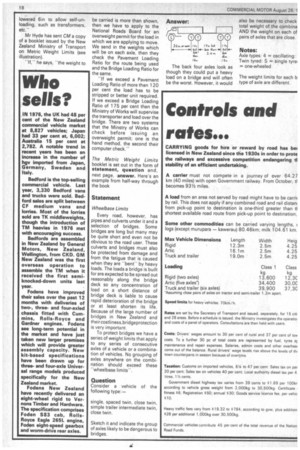Who sells?
Page 20

If you've noticed an error in this article please click here to report it so we can fix it.
IN 1976, the UK had 48 per cent of the New Zealand commercial vehicle market at 8,827 vehicles; Japan had 33 per cent at, 6,002; Australia 15 per cent at 2,782. A notable trend in recent years has been an increase in the number of hgv imported from Japan, Germany, Sweden and
Italy.
Bedford is the top-selling commercial vehicle. Last year, 3,330 Bedford vans and trucks were sold. Bedford sales are split between CF medium vans and lorries. Most of the lorries sold are TK middleweights, though the introduction of TM heavies in 1976 met with encouraging success.
Bedfords are assembled in New Zealand by General Motors, New Zealand, Wellington, from CKD. GM New Zealand was the first overseas operation to assemble the TM when it received the first semiknocked-down units last year.
Fodens have improved their sales over the past 12 months with deliveries of two-, threeand four-axled chassis fitted with Cummins, Rolls-Royce and Gardner engines. Fodens see long-term potential in the market and have just taken new larger premises which will provide greater assembly capacity. New kit-based specifications have been drawn up for threeand four-axle Universal range models produced specifically for the New Zealand market.
Fodens New Zealand have recently delivered an eight-wheel rigid to Vernons Timber and Hardware. The specification comprises Foden S83 cab, RollsRoyce Eagle 2651 engine, Foden eight-speed gearbox and worm-drive rear axles. be carried is more than shown, then we have to apply to the National Roads Board for an overweight permit for the load in which we are applying to move. We send in the weights which will be on each axle, then they check the Pavement Loading Ratio for the route being used and the Bridge Loading Ratio for the same.
"If we exceed a Pavement Loading Ratio of more than 120 per cent the load has to be stripped or better unit required. If we exceed a Bridge Loading Ratio of 175 per cent then the Ministry of Works will supervise the transporter and load over the bridge. There are two systems that the Minstry of Works can check before issuing an overweight permit; one is the hand method, the second their computer check."
The Metric Weight Limits booklet is set out in the form of statement, question and, next page. answer. Here's an example from half-way through the book












































































